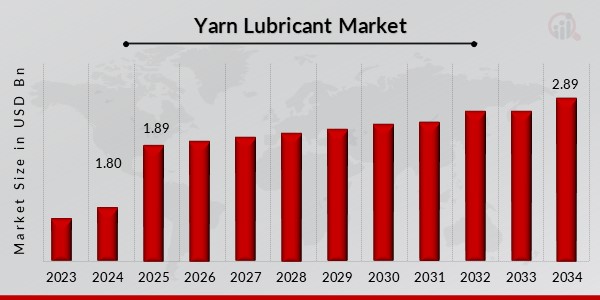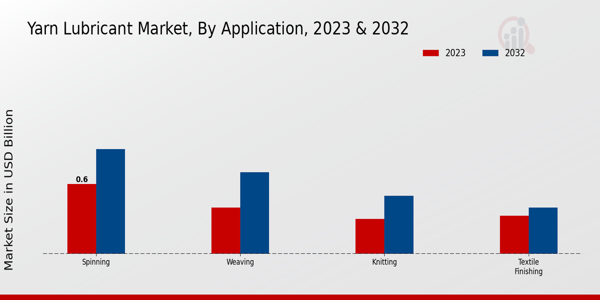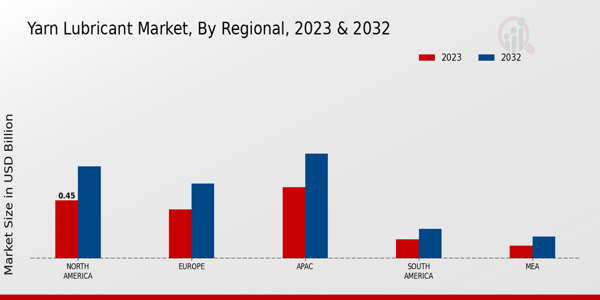Global Yarn Lubricant Market Overview
The Yarn Lubricant Market Size was estimated at 1.80 (USD Billion) in 2024. The Yarn Lubricant Industry is expected to grow from 1.89 (USD Billion) in 2025 to 2.89 (USD Billion) by 2034. The Yarn Lubricant Market CAGR (growth rate) is expected to be around 4.85% during the forecast period (2025 - 2034).
Key Yarn Lubricant Market Trends Highlighted
The Yarn Lubricant Market is witnessing growth due to the increasing utilization of synthetic and natural fibers in various sectors like textiles, automotive, and construction. With the improvement in manufacturing processes, yarn lubricants have become imperative since manufacturers are always in search of improving efficiency and quality. Such lubricants are essential for enhancing the performance and efficiency of textile machinery and operations. In addition, an increasing market for sustainable textiles is causing suppliers to create green lubricants that will capture the growing demand and attention to ecofriendly practices.
The update not only satisfies the needs of the consumer but also aids in meeting the broader environmental objectives.
There are many opportunities existing in the development of advanced yarn lubricants optimized for particular use. Major players are working on design aspects of smart lubricants which will work under different production conditions and help operating efficiency. The increasing automation level in manufacturing provides one more opportunity for development, allowing lubricant producers to incorporate new technologies into their products. Also, a rapidly growing market in the Asia-Pacific region offers great opportunities for growth due to the growing production capacities and relative development of the textile industries.
In line with contemporary trends, there has been an increasing focus on R&D, with organizations aiming at quality improvement and enhancement of the performance characteristics of yarn lubricants.
The bio-based lubricants are an emerging trend that is in line with the general drive towards renewable sources. The increasing engagement among manufacturers and end-users allows tailored solutions targeted at particular production processes. This progress is likely to enhance interactions amongst entities within the supply chain, further promoting the development of more robust, efficient, and environmentally sustainable yarn lubricants.

Source Primary Research, Secondary Research, Market Research Future Database and Analyst Review
Yarn Lubricant Market Drivers
Increasing Demand from the Textile Industry
The Yarn Lubricant Market Industry is significantly driven by the increasing demand for wrapped yarns from the textile industry. As textile manufacturing continues to grow globally, the requirement for high-quality yarn has led to a surge in the consumption of yarn lubricants.
These lubricants play a crucial role in the production process by enhancing the efficiency of machines, reducing wear and tear, and improving the overall quality of the final products.The textile industry’s ongoing innovation and expansion, particularly in emerging economies, have resulted in a heightened focus on streamlining operations and improving the production of yarn, which directly impacts the demand for yarn lubricants.
Furthermore, as manufacturers strive to meet changing consumer preferences and trends towards sustainable and high-performance fabrics, the need for specialized yarn lubricants that cater to these innovations has become more pronounced.The industry is witnessing a shift towards eco-friendly lubricants, which are driving new product development within the Yarn Lubricant Market Industry. As sustainability becomes a central theme in various sectors, especially textiles, yarn lubricants formulated from renewable sources or those that minimize environmental impact are gaining traction.
This shift not only aligns with sustainability goals but also meets consumer expectations for greener production practices.Additionally, as manufacturers explore new markets and expand production capacities, there is an increased utilization of advanced weaving and knitting technologies that require specialized yarn lubricants to maintain optimal performance and reduce operational costs.
This adoption of technology further propels market growth, especially in regions with fast-evolving textile production capabilities, where there is a pressing need to balance quality output with operational efficiency.The adoption of automation in textile manufacturing adds another layer of complexity and drives the demand for advanced yarn lubricants capable of functioning under varied operating conditions, contributing to the anticipated growth and innovation within the Yarn Lubricant Market Industry.
Technological Advancements in Lubricant Formulations
Technological advancements in lubricant formulations are a key driver of the Yarn Lubricant Market Industry. As research and development in product formulation progress, manufacturers are now able to create more efficient and effective lubricants tailored for specific applications. The introduction of synthetic and bio-based lubricants enhances performance parameters such as temperature stability, lubrication efficiency, and compatibility with various textile processes.These advancements not only help in reducing machine downtime but also improve the lifespan of the machinery used in yarn manufacturing. This technological enhancement ultimately boosts productivity and quality in textile production.
Growing Awareness About Sustainable Practices
The rising awareness about sustainable practices within textile manufacturing significantly influences the Yarn Lubricant Market Industry. As consumers and industries push for more environmentally safe products, the demand for eco-friendly yarn lubricants is increasing. This awareness encourages manufacturers to invest in sustainable production methods, leading to the development of lubricants that minimize environmental impact and align with green practices.Consequently, companies that adapt their products to meet these environmentally friendly standards position themselves favorably in the market.
Yarn Lubricant Market Segment Insights
Yarn Lubricant Market Application Insights
The Yarn Lubricant Market is experiencing steady growth, with an expected valuation of 1.63 USD Billion in 2023, projected to grow to 2.5 USD Billion by 2032. This market segmentation highlights the various applications within the industry, which include Spinning, Weaving, Knitting, and Textile Finishing. The Spinning application holds a significant portion of the market, valued at 0.6 USD Billion in 2023 and forecasted to reach 0.9 USD Billion in 2032, showcasing its dominance in the overall landscape of yarn lubricants.
This segment's importance lies in its role in enhancing the efficiency and quality of yarn production, thus catering to the growing demand in textile manufacturing.Weaving, another key application, held a market value of 0.4 USD Billion in 2023 with projections of reaching 0.7 USD Billion by 2032. This segment is critical as it involves the interlacing of yarns, where lubricants play a crucial part in reducing friction and preventing damage during the weaving process. Knitting, valued at 0.3 USD Billion currently, is similarly projected to grow to 0.5 USD Billion by 2032.
This application benefits yarn lubricants by improving the smooth flow of yarn through knitting machines, which enhances the quality of knitted fabrics. Meanwhile, the Textile Finishing application, valued at 0.33 USD Billion in 2023 and expected to rise to 0.4 USD Billion by 2032, represents an essential area where yarn lubricants contribute to enhancing the final look and feel of textiles, ensuring durability and wear resistance.The segmentation within the Yarn Lubricant Market indicates a variety of trends, growth drivers, and challenges that influence its overall trajectory.
Factors such as the increasing demand for high-quality finishing textiles and advancements in yarn lubrication technology are driving the growth in these application areas. However, challenges such as fluctuating raw material prices and the need for environmentally friendly lubricants may impact the market dynamics. Nevertheless, opportunities are abundant as industries seek more efficient productions methods, which can be significantly enhanced through the use of specialized yarn lubricants. Understanding the Yarn Lubricant Market data across these application segments offers a comprehensive perspective on the industry's future and the factors that will shape its growth.

Source Primary Research, Secondary Research, Market Research Future Database and Analyst Review
Yarn Lubricant Market Type Insights
The Yarn Lubricant Market is projected to reach a valuation of 1.63 billion USD in 2023, highlighting the importance of the diverse types within this industry. The market is segmented into Natural Lubricants, Synthetic Lubricants, and Biodegradable Lubricants, each catering to different industry requirements and consumer preferences. Natural lubricants have gained traction due to their eco-friendly attributes, offering a sustainable alternative.
On the other hand, synthetic lubricants dominate the market due to their superior performance in extreme conditions, making them a preferred choice among manufacturers.Biodegradable lubricants are also significant, reflecting a rising trend towards sustainability and environmental responsibility, as they minimize ecological impact. As the Yarn Lubricant Market continues to evolve, both growth drivers and challenges present opportunities for innovation, particularly in developing enhanced formulations and sustainable practices aligned with industry regulations and consumer expectations. Consistently analyzing Yarn Lubricant Market data and statistics will be essential to stay competitive and responsive to market changes in the coming years.
Yarn Lubricant Market Formulation Type Insights
The Yarn Lubricant Market is experiencing steady growth, with the market expected to be valued at 1.63 billion USD in 2023. Focusing on the Formulation Type segment, the market is divided into various categories, including Water Soluble, Oil-Based, and Emulsion formulations. Water Soluble lubricants are becoming more prominent due to their environmental benefits and ease of cleaning, making them a popular choice among manufacturers.
On the other hand, Oil-Based lubricants dominate the market due to their superior lubrication properties, providing enhanced performance in textile production processes.Emulsion-based lubricants offer versatility and are increasingly utilized in spinning and other processes where lubrication control is critical. Collectively, these formulations contribute significantly to the overall Yarn Lubricant Market revenue, indicating a dynamic landscape shaped by innovation and evolving customer preferences. Market growth in this sector is also propelled by rising demand from the textile industry and the need for high-performance lubricants to improve efficiency and reduce production downtime.
However, challenges such as regulatory pressures and environmental concerns may impact market dynamics.Overall, this segment highlights the importance of formulating effective yarn lubricants to meet industry needs while navigating various market trends and challenges.
Yarn Lubricant Market End Use Insights
The Yarn Lubricant Market, valued at 1.63 billion USD in 2023, showcases a diverse segmentation based on End Use, significantly impacting its trajectory. Among these segments, the apparel category holds considerable importance due to its high demand for various fabrics, driving the need for effective yarn lubricants. In addition, home textiles play a crucial role in the market, with growing consumer interest in home furnishings leading to a rise in demand for innovative textile solutions.
Meanwhile, technical textiles dominate the market due to their application in various industries, including automotive and healthcare, necessitating advanced lubricant formulations to enhance performance and durability.The Yarn Lubricant Market data suggests a steady growth in these segments, fueled by increasing production capacities and technological advancements. Market trends indicate a shift towards sustainable and eco-friendly lubricants as consumers prioritize environmentally responsible products. However, challenges such as fluctuating raw material prices and stringent regulations on chemical usage pose potential hurdles for the market. Overall, significant growth opportunities exist, driven by the rising demand across all key sectors.
Yarn Lubricant Market Regional Insights
The Yarn Lubricant Market is anticipated to witness noteworthy progress across its regional segments, with a total market value of 1.63 USD Billion in 2023, reaching 2.5 USD Billion by 2032. In 2023, North America holds a significant share valued at 0.45 USD Billion, expected to grow to 0.71 USD Billion, indicating its dominant position in the industry due to advanced manufacturing facilities and high demand for high-quality yarn products.
Europe follows closely with a valuation of 0.38 USD Billion in 2023 and is projected to reach 0.58 USD Billion, benefiting from strong textile industry practices.The APAC region, valued at 0.55 USD Billion in 2023, presents substantial opportunities for growth due to its rapidly expanding textiles market and cost-effective production capabilities, expecting to grow to 0.81 USD Billion.
Conversely, South America and the MEA regions hold smaller shares, with valuations of 0.15 USD Billion and 0.10 USD Billion respectively in 2023, demonstrating a growing but limited presence in the market, which may be attributed to lesser industrialization compared to other regions. The Yarn Lubricant Market statistics illustrate a varied landscape where North America and APAC emerge as key players, contributing significantly to market growth through innovation and demand for yarn lubricants.

Source Primary Research, Secondary Research, Market Research Future Database and Analyst Review
Yarn Lubricant Market Key Players and Competitive Insights
The Yarn Lubricant Market is witnessing a wave of competitive dynamics driven by the increasing demand for high-quality yarns in the textile industry. As manufacturers strive to enhance the performance and durability of yarns, the role of lubricants becomes critical in the spinning process. Companies within this market are focused on developing innovative products that improve operational efficiencies, reduce friction, and enhance the final texture of the yarn. The competition is characterized by a mix of established players and newer entrants, all aiming to capture market share through strategic product differentiation, customer-centric solutions, and expansion into emerging markets.
Additionally, the growing emphasis on sustainability and environmentally friendly products is influencing product formulations, leading to a trend where companies invest in research and development to meet these evolving consumer preferences.Wacker Chemie holds a significant position in the Yarn Lubricant Market, recognized for its strength in high-performance silicone-based lubricants that cater specifically to the requirements of textile manufacturers. The company possesses a robust research and development framework that enables it to innovate and adapt its product lines to meet changing industry trends.
Wacker Chemie's commitment to quality and sustainability distinguishes its offerings, providing products that not only enhance yarn quality but also minimize environmental impact. This strategic focus has allowed Wacker Chemie to develop strong relationships with key players in the textile sector, thereby ensuring a competitive edge in a rapidly evolving market landscape.
The company's established presence further reinforces its ability to meet diverse customer needs across various regions, adapting to local market dynamics effectively.Houghton International is another vital player in the Yarn Lubricant Market, known for its extensive range of specialty lubricants tailored to meet the complexities of yarn production across different materials. The company leverages its expertise in tribology, fostering innovations that enhance lubrication performance and reliability throughout the manufacturing process. Houghton International's solutions are designed with advanced formulations to ensure the smooth operation and longevity of textile machinery, ultimately contributing to cost efficiency for customers.
The strength of Houghton International lies in its ability to offer customized lubricant solutions, catering to the specific requirements of different production settings and materials. Moreover, Houghton International's footprint and dedicated customer service enable it to build strong partnerships with manufacturers, ensuring that it remains competitive in the ever-evolving landscape of the yarn lubricant sector.
Key Companies in the Yarn Lubricant Market Include
Yarn Lubricant Market Industry Developments
The Yarn Lubricant Market has recently witnessed significant developments, particularly in sustainability efforts. Companies like BASF and DOW are focusing on eco-friendly lubricant formulations to meet increasing regulatory requirements and environmental consciousness among consumers. Houghton International has announced enhancements to their product lines to improve efficiency and reduce friction, thereby leading to operational cost savings for manufacturers. In terms of mergers and acquisitions, Wacker Chemie has successfully acquired a regional player to strengthen its market presence and broaden its product offerings within the yarn lubrication space.
This trend towards consolidation is indicative of the aggressive strategies companies are pursuing to capture larger market shares. Additionally, Evonik Industries has been investing in research and innovation to develop high-performance lubricants tailored specifically for synthetic yarn applications, further driving market growth. The overall valuation of the Yarn Lubricant Market is expected to rise, positively impacting stakeholders involved in textile production as they seek advanced solutions to improve their operational efficiency. With major players like AkzoNobel, Shell, and TotalEnergies also increasing their footprint, competition in this market is becoming increasingly dynamic, shaping future trends in the industry.
Yarn Lubricant Market Segmentation Insights
-
Yarn Lubricant Market Application Outlook
-
Yarn Lubricant Market Type Outlook
-
Yarn Lubricant Market Formulation Type Outlook
-
Yarn Lubricant Market End Use Outlook
-
Yarn Lubricant Market Regional Outlook
| Report Attribute/Metric |
Details |
| Market Size 2024 |
1.80 (USD Billion) |
| Market Size 2025 |
1.89 (USD Billion) |
| Market Size 2034 |
2.89 (USD Billion) |
| Compound Annual Growth Rate (CAGR) |
4.85% (2025- 2034) |
| Report Coverage |
Revenue Forecast, Competitive Landscape, Growth Factors, and Trends |
| Base Year |
2024 |
| Market Forecast Period |
2025- 2034 |
| Historical Data |
2020 - 2024 |
| Market Forecast Units |
USD Billion |
| Key Companies Profiled |
Wacker Chemie, Houghton International, Cargill, Texaco, Evonik Industries, DOW, Fuchs Petrolub, AkzoNobel, TotalEnergies, BASF, Momentive, Clariant, Lubrizol, Omnova Solutions, Shell |
| Segments Covered |
Application, Type, Formulation Type, End Use, Regional |
| Key Market Opportunities |
Sustainable lubricant formulations, Increased demand from emerging economies, Innovations in application techniques, Growing textile production rates, Shift towards eco-friendly products |
| Key Market Dynamics |
growing textile industry demand, increasing performance requirements, eco-friendly lubricant alternatives, technological advancements in formulation, fluctuation of raw material prices |
| Countries Covered |
North America, Europe, APAC, South America, MEA |
Frequently Asked Questions (FAQ):
The Yarn Lubricant Market is projected to be valued at 2.89 USD Billion by the year 2034.
The expected CAGR for the Yarn Lubricant Market from 2025 to 2034 is 4.85%.
North America is expected to hold the largest market share, with a value of 0.71 USD Billion by 2032.
The 'Spinning' application is projected to be valued at 0.9 USD Billion by the year 2032.
The 'Weaving' application is projected to reach a market size of 0.7 USD Billion by 2032.
Key players in the market include Wacker Chemie, Houghton International, Cargill, and Texaco among others.
The 'Knitting' application is expected to reach a market size of 0.5 USD Billion by 2032.
The 'Textile Finishing' application is expected to be valued at 0.4 USD Billion by the year 2032.
In the Asia-Pacific region, the market is projected to reach a value of 0.81 USD Billion by 2032.
The market may face challenges such as fluctuating raw material prices and stringent environmental regulations.

















